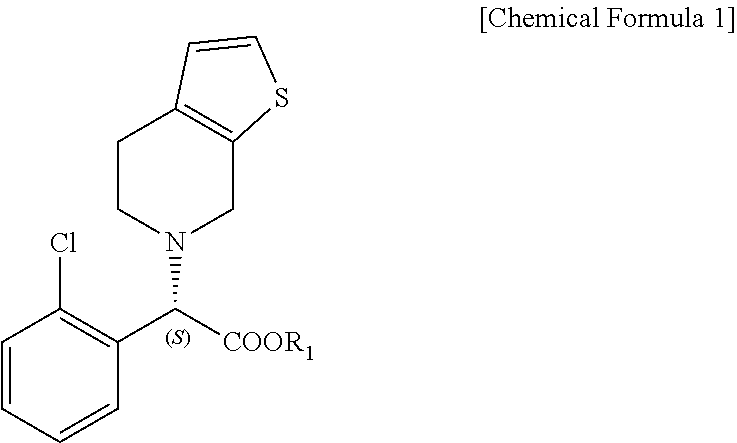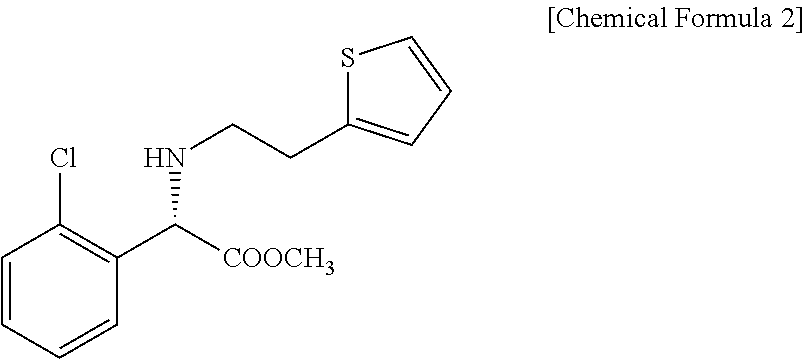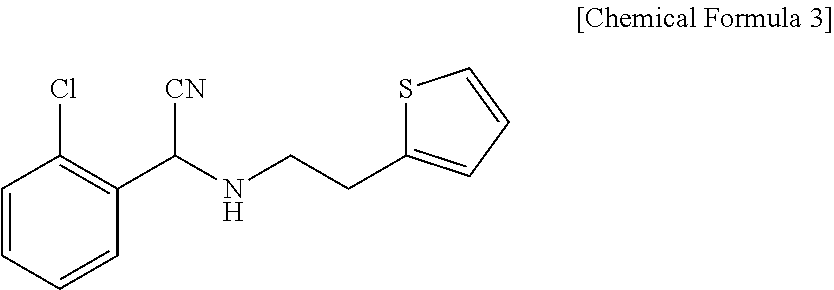Method for preparing clopidogrel and its derivatives
a technology of clopidogrel and derivatives, applied in the field of preparing clopidogrel and derivatives thereof, can solve the problems of reducing yield, requiring a relatively long time, and requiring days to perform optical isolation
- Summary
- Abstract
- Description
- Claims
- Application Information
AI Technical Summary
Benefits of technology
Problems solved by technology
Method used
Image
Examples
example 1
Preparation of Racemic 2-Chlorophenyl Glycine Alkyl Ester
[0032]To 500 ml of methanol, 100 g of racemic 2-chlorophenylglycine is introduced and 70 ml of thionyl chloride is added gradually dropwise thereto at −10°. Next, the reaction mixture is warmed to 50° and agitated for 4 hours. After the agitation, the reaction mixture is concentrated under reduced pressure to remove volatile materials. Then, IL of methylene chloride and 100 ml of water are added to dilute the mixture, which, in turn, is neutralized with aqueous NaOH. The resultant organic layer is washed with 500 ml of aqueous saturated NaHCO3 solution. From the washed mixture, methylene chloride layer is separated, dried over MgSO4 and concentrated under reduced pressure to obtain 104.6 g of racemic 2-chlorophenylglycine methyl ester 1a (yield: 97.3%).
[0033]Meanwhile, butanol is used instead of methanol and the reaction is carried out under the same condition as described above to obtain 120.4 g of racemic 2-chlorophenylglyci...
example 2
Preparation of Optically Active (S)-2-chlorophenylglycine Alkyl
Ester via Hydrolysis
[0034]To a reactor containing 1,000 ml of 0.1M potassium phosphate buffer (pH 7.5), 200 g of racemic 2-chlorophenylglycine methyl ester 1a obtained from Example 1 is introduced, and 10 ml (1%, v / v) of alcalase 2.5 L enzyme is added thereto. The reaction mixture is allowed to react at 30° C. under 250 rpm. To maintain a constant pH, 2N aqueous NaOH solution is introduced to the reaction mixture. After carrying out the reaction for 24 hours, 1,000 ml of ethyl acetate is added to the reaction mixture to extract optically active (S)-2-chlorophenylglycine methyl ester 2a having an optical purity of at least 99%, which, in turn, is dried over MgSO4 and concentrated under reduced pressure to obtain 85.6 g of (S)-2-chlorophenylglycine methyl ester 2a having an optical purity of 99.8% ee (yield: 85.6% Vs. (S)-enantiomer).
[0035]Meanwhile, racemic 2-chlorophenylglycine butyl ester 1b is used instead of racemic 2...
example 3
Preparation of Optically Active (S)-Alkyl-α-(2-thienylethylamino)(2-chlorophenyl)acetate hydrochloride
[0038]First, 100 g of (S)-2-chlorophenylglycine methyl ester 2a obtained from Example 2 is dissolved into 1,000 ml of acetonitrile, 60 g of potassium bicarbonate and 156 g of paratoluene sulfonate are added thereto, and the resultant mixture is refluxed for 20 hours. The mixture is depressurized to remove volatile materials therefrom and dissolved into ethyl acetate, and then the organic layer is washed with distilled water. After the separation of the organic layer, concentrated hydrochloric acid is added at 0° C. to perform precipitation of crystals, which, in turn, is dried under vacuum to provide 125.4 g of (S)-methyl-α-(2-thienylethylamino)(2-chlorophenyl)acetate 3a in the form of hydrochloride (yield: 72.3%).
[0039]Meanwhile, (S)-2-chlorophenylglycine butyl ester 2b is used instead of (S)-2-chlorophenylglycine methyl ester 2a, and the reaction is carried out under the same cond...
PUM
 Login to View More
Login to View More Abstract
Description
Claims
Application Information
 Login to View More
Login to View More - R&D
- Intellectual Property
- Life Sciences
- Materials
- Tech Scout
- Unparalleled Data Quality
- Higher Quality Content
- 60% Fewer Hallucinations
Browse by: Latest US Patents, China's latest patents, Technical Efficacy Thesaurus, Application Domain, Technology Topic, Popular Technical Reports.
© 2025 PatSnap. All rights reserved.Legal|Privacy policy|Modern Slavery Act Transparency Statement|Sitemap|About US| Contact US: help@patsnap.com



